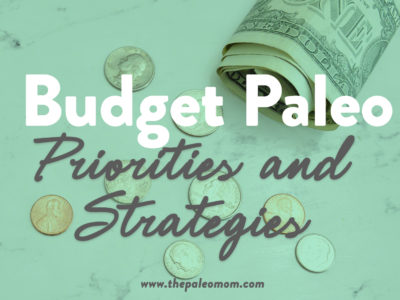In a perfect world, our diets would consist purely of pasture-raised meat, free-range poultry, wild game, wild-caught fish, and organic, locally-grown seasonal fruits and vegetables. The fact is that this is prohibitively expensive for many families, including mine. But does that mean you can’t eat a Paleolithic diet? Of course not! Feeding a family a Paleolithic diet on a budget is similar to any budget constraint: it’s all about priorities and some good money-saving strategies.
As for priorities, I would love to buy exclusively pasture-raised meat so that I don’t need to think much about our omega-3 versus omega-6 intake. But, instead I balance our omega-3 intake using canned wild-caught fish, omega-3 eggs, and some butter from grass-fed cows. I buy a wide variety of fruits and vegetables, organic when the price difference isn’t too great. Usually, whatever is in season is cheaper anyway.
Not surprisingly, the biggest money-saver for eating Paleo on a budget is investing time. Actually, time ends up being an important component of Paleolithic nutrition anyway because many convenience foods contain ingredients we’re trying to avoid (fortunately, avoiding pre-packaged foods ends up saving money). I try and optimize my time investment by making a huge batch of a recipe and either eating it for a few consecutive days or freezing several meals worth (or both!). Also useful is devoting some time each week to chopping veggies for the freezer (useful for quick stir-fries, frittatas and side dishes later in the week).
Other money savers include: buying in bulk, taking advantage of sales and coupons, using discount stores, and buying specialty items online. I save a ton of money by having extra virgin coconut oil, blanched almond flour, unsweetened coconut flakes, and high quality canned sardines shipped directly to my house.
It also helps to know your prices. I have a brain for numbers, so it’s easy for me to keep track of which stores have the best prices on which items. If this is a bit much for you, try keeping a simple spreadsheet of your most common items in your phone or on a scrap piece of paper in your purse or wallet. You don’t need to get the best price on every grocery item you buy, but it really helps to get the best price on your most commonly used items. This also helps in taking advantage of sales. I have certain grocery items that I look at every time I am in the store to see if they are on sale (things like cauliflower, frozen vegetables, good quality meats, and frozen wild caught fish). When red bell peppers go on sale for one dollar each, I buy four or five, then spend some time chopping them for the freezer.
As my mother is fond of saying, “Waste not, want not.”. I try never to throw anything out. When I roast a chicken, I always make bone broth out of the carcasses (see recipe). When my kids eat only half a banana, I peel the other half and stick it in a re-sealable bag in the freezer. Then, when I have the equivalent of two or three bananas in that bag, I use them to bake Paleo banana muffins. I also keep a close eye on the produce in my fridge to make sure that it gets used or frozen before going bad.
Finally, it helps to have a repertoire of cheaper meals (like soups, stews, frittatas, and pumpkin chili!). Even if you have to make some sacrifices to implement Paleolithic nutrition for yourself and for your family (like buying regular whole chicken instead of free-range), you are doing a great thing to improve your health!




